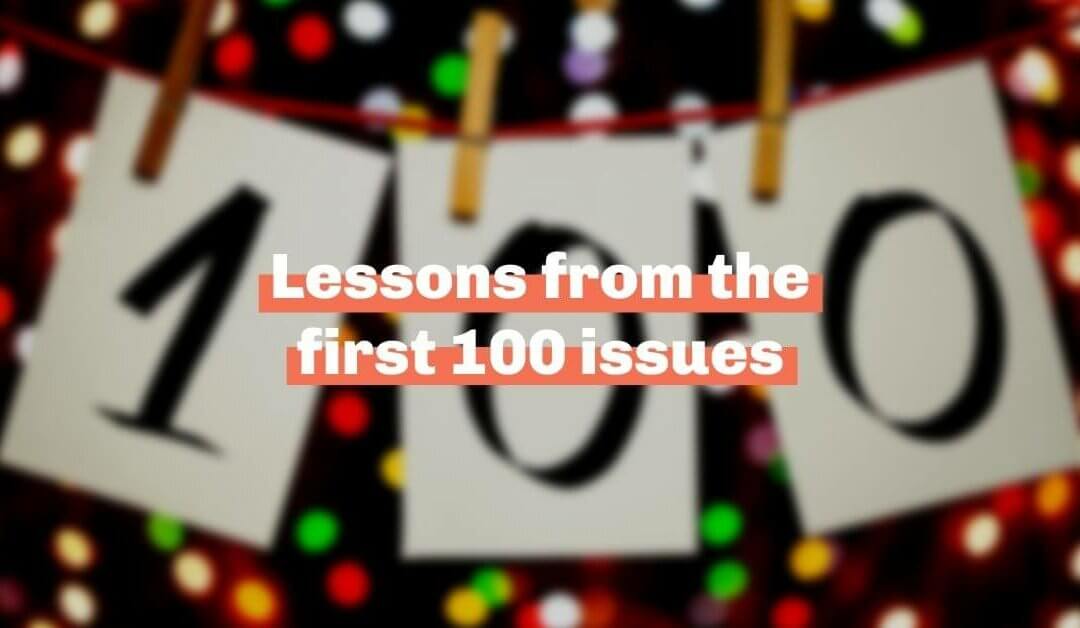by Lindsey Lincoln | Sep 7, 2023 | Guides
Does your nonprofit have a regular newsletter? Monthly, bimonthly, or quarterly email newsletters are a great way to communicate with your supporters—and we almost always recommend them to our clients. Our guide to nonprofit newsletters includes best practices, data-backed tips, ideas to test, and a treasure trove of resources to inform your newsletter strategy.
Nonprofit Newsletters we love…
- Have a distinct voice. You feel like you are connected to an author, even when they’re just sending you a list of bullet points or recommended links.
- Are simple and skimmable. There is something to a super unformatted email – or at least a minimally formatted email. And know that people are cruising – can they get what they need from just the headlines?
- Almost always have at least one thing we want to click. Know your audience – and know what they might enjoy!
- Are personalized. It sounds like it’s from a real person being written to a real person.
- Make it clear what they want us to do. They have one prominent CTA, even if they have a bunch of links throughout.
- Are designed with lots of white space (our favorite in all emails!).
- Keep a really healthy list. Be ruthless on list health (even if that means cutting people off).
- Are a conversation. Instead of blasting the reader with information, they speak to their existing concerns and welcome feedback and ideas.
- Aggregate content from other sources, saving me time and the need to follow every quality source out there.
Data shows…
- Keep subject lines short and clear. Aim for eight words or less (per recent suggestions based on iPhone preview text) and say what is actually in the newsletter/why it’s of value for the reader.
- Your email MUST be mobile-optimized. (Mobile first in everything these days, really.)
- Streamlining matters. Make it SUPER clear (and explicit) what your newsletter is about. Ie: Here are eight stories about your impact this month that you don’t want to miss.
Consider testing…
- A survey for newsletter subscribers. What do they WANT to read/see/receive?
- Removing the marketing template entirely. (Check out this study.)
- Choosing a person in the organization who is the “newsletter” person. It always comes from them. People can reply to them. It’s written in a super human voice. And it makes the newsletter stand out from other communications from their DPs.
- An all text newsletter that feels like a real person wrote it
- Creative subject lines. Have some fun and get people to OPEN! Don’t be afraid to step out of your comfort zone, you want to catch people’s attention.
- Z-pattern design instead of straight columns.
- Segmenting newsletter topics or the order of topics based on interests or other factors
Learn more about nonprofit newsletters…

by Allison Kooser | Dec 16, 2021 | +Good Newsletter, The Intro
Welcome to the 100th edition of +good! (We know—we can hardly believe it, either!)
We’ve been sharing our thoughts on marketing, fundraising, leadership, team dynamics, and keeping our work lives fun for almost two years. We’ve compiled the tools and articles that inspire us. And we’ve had the opportunity to connect with so many extraordinary nonprofit leaders like you!
(You’re awesome, by the way!)
Over the course of 100 editions, we’ve learned a few things—lessons that, yes, apply to an email newsletter but also apply to so many pieces of our work.
Having a creative outlet of your own is good for you.
Writing these intros is one of the best parts of my week. In a schedule full of writing for other people, having a dedicated hour to put pen to paper about the things I am personally thinking about is such a gift. Plus, it’s a great way to process all of the content I’m consuming regularly. And you don’t need a newsletter to do this—open a notebook or a doc and get started!
It’s ok to say no.
There have been weeks when the newsletter felt like one thing too many, so you know what we did? We skipped an issue. Yep. We just decided that it wasn’t worth the added stress. This ability to own our work (instead of letting our work own us) is one of the best parts of being our own bosses. And hopefully, you feel this same kind of freedom in some of your assignments!
You can be wrong.
Curating a list of marketing tips and tricks every week has been a learning experience for our entire team. And one of the best parts of pulling together the meat of the newsletter is realizing that we can (and should) challenge our way of thinking, too. Constant learning and curiosity are core tenets of our business—and that means we’re constantly rethinking the way we do things.
Community is what it’s all about.
Hearing from you, our awesome readers, is one of the best parts of writing this newsletter. Knowing that our messages resonate (or that you’ve finally taken control of your calendar, started canceling meetings, or stepped up your leadership game) brings us so much joy. In fact, it’s why we do this thing in the first place. You’re our why—and we love getting to know you!
Thank you for reading along with us for 100 issues—and here’s to the next 100 ahead of us! If there are things you’d like to hear more about (or less about!) please let us know by replying to this email. We are always looking for inspiration, and we know you have a ton of it!
Until then, know that you are doing great, hard, powerful work. Work that makes a difference. Work that is making the world better. We are cheering for you and honored to be in your inbox!
In the spirit of saying no and protecting our schedules, we’re taking the next two weeks off from the newsletter to enjoy time with our families. Hope you have a fantastic holiday—and we’ll see you in 2022!

by Ian Haisley | Aug 6, 2021 | +Good Newsletter
1. The metaverse and the not-so-distant future of the internet. 💻
First things first, what is a metaverse? It’s an old sci-fi term for a seamless virtual world experienced by first-person users with augmented reality technology. And according to Mark Zuckerberg, Facebook’s transition from social media into “a metaverse company”, is not as far away as you might think. So what does this mean for you? And how long do we have to wait before this is our reality?
Dive into the metaverse. [via Digiday]
2. Maximize the ROI from your newsletter! 💪
If you underestimate your email marketing returns, you might be shutting your eyes to some huge potential. Businesses get an average of $42 out of every dollar put into a well-planned email marketing strategy—and we’d love for you to be part of that statistic! Learn about unique strategy building, success metrics to pay attention to, and how to help your emails meet their targets by checking out the link below! (And, as always, we’d love to help you get your email marketing rocking and rolling!)
15 ways to get even more ROI from your emails. [via Databox]
3. Don’t 🛑 make the most common monthly giving mistake.
Is it sending your donors too many messages? Putting the wrong titles in your newsletters? The answer is actually much more simple, and it’s something you can work on right now! Read below about the single easiest tactic to start boosting your monthly donations.
What’s the most common monthly giving mistake? [via A Direct Solution]
4. Start using episodic content. 🍿🍿
We’re all guilty of binge-watching our favorite shows, but what if you could bottle that anticipation and use it to keep your donors hooked? You don’t have to run a TV show, you just have to keep your audience engaged with content that makes the most of your organization’s stories!
Learn how to leverage episodic content from the experts. [via Content Marketing Institute]
5. How to test for barriers in your email 📝 flow.
If your emails are not producing your desired results, there are three likely culprits: barriers to deliverability, display issues, or lack of engagement. But how can you diagnose the problem? We’ve collected an email testing toolkit to help you 1) find what’s blocking your flow and 2) avoid easy email testing mistakes.
Start sending better emails. [via Smashing Magazine]


